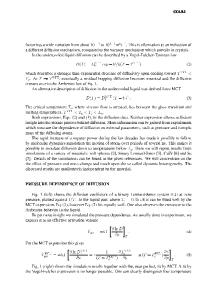Diffusion in Metallic Glasses and Supercooled Melts
- PDF / 165,500 Bytes
- 12 Pages / 612 x 792 pts (letter) Page_size
- 113 Downloads / 413 Views
DIFFUSION IN METALLIC GLASSES AND SUPERCOOLED MELTS F. Faupel, K. Rätzke, H. Ehmler1, P. Klugkist2, V. Zöllmer, C. Nagel3, A. Rehmet4, and A. Heesemann5 Lehrstuhl für Materialverbunde, Technische Fakultät der Universität Kiel, Kaiserstr. 2, D-24143 Kiel, Germany, [email protected] 1
Now at: MPI für Plasmaphysik, Boltzmannstr. 2, D-85748 Garching, Germany Now at:MPI für Metallforschung, Seestr. 92, D-70174 Stuttgart, Germany 3 Now at: Fraunhofer Institut für Fertigungstechnik und Materialforschung, Wiener Str. 12, D-28359 Bremen, Germany 4 On leave from: I. Phys. Institut and SFB 345, Bunsenstr. 9, D-37073 Göttingen, Germany 5 Now at: RELOG GmbH, Marconistr., D-24145 Kiel, Germany 2
ABSTRACT Diffusion in metallic glasses and in the supercooled liquid state is of considerable interest not only from the technological point of view but also in terms of fundamental science, particularly in connection with the glass transition. Within the framework of the mode coupling theory the glass transition is a kinetic phenomenon characterized by the arrest of viscous flow at a critical temperature Tc well above the calorimetric glass transition temperature Tg. Below Tc the theory predicts cooperative hopping processes. We present results from isotope effect measurements which indeed confirm the highly collective nature of diffusion in metallic glasses and suggest cooperative hopping processes to be closely related to the universal low-frequency excitations as observed in recent molecular dynamic simulations. In accord with the mode coupling scenario these cooperative hopping processes are also observed in the supercooled liquid state of the new bulk metallic glasses well above Tg. The reported kink in the Arrhenius plot for diffusion of various elements is shown to be related to structural changes above Tg, e.g., an increase in free volume as probed by positron annihilation, but not to a change in the diffusion mechanism. Measurements of the activation volume of diffusion indicate that, depending on the structure of the glass, cooperative hopping may take place without assistance of thermally generated defects or via delocalized thermal defects. Moreover, we provide evidence of the existence of an opposite Kirkendall effect in interdiffusion between certain amorphous alloys that combine slow diffusion via thermal defects and fast direct diffusion. INTRODUCTION Metallic glasses are the paradigm of dense random packing and are also of considerable technological importance [1,2]. They combine properties of ordinary glasses with the ductility of metals and may exhibit excellent soft-magnetic properties, for instance. Meanwhile, the new bulk metallic glasses introduced by Inoue [3] and Johnson [4] which can be produced at low cooling rates offer hosts of new applications [5]. Particularly encouraging are recent studies demonstrating the possibility to overcome the intrinsic work softening problem [6]. Since metallic glasses are nonequilibrium materials they undergo various rearrangement processes such as structural relaxation, phases
Data Loading...











